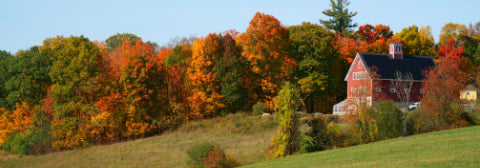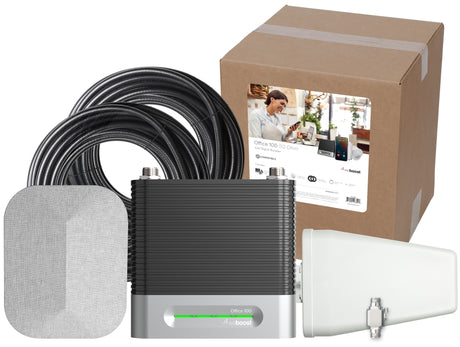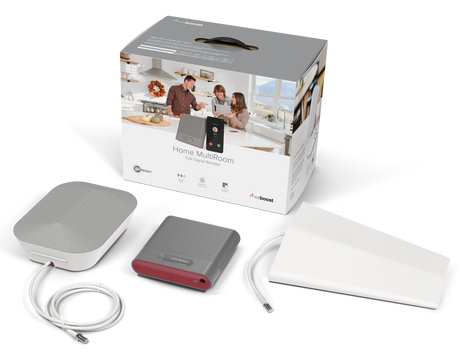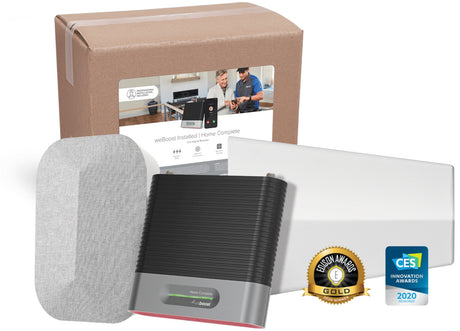If you want the most powerful antennas and ability to customize your booster setup to perfectly fit your building, then a self-installed solution is for you. As long as you're handy, this choice provides the best boosting and maximum coverage for your space.
Best Self-Installed Boosters for Rural Areas
-
weBoost 200 Signal Booster with High-Gain LPDA for Rural Areas
From $1,899.99Unit price /Unavailable -
-
Best Solutions that Include Professional Installation
If you're looking for a hassle-free installation that can be done quickly by a professional, then these are the best options for you.
-
weBoost Installed | Home Complete - Includes Professional Installation (474445)
$1,499.99Unit price /Unavailable -
weBoost Installed Office 300 - Includes Professional Installation | 479047
$3,799.99Unit price /Unavailable
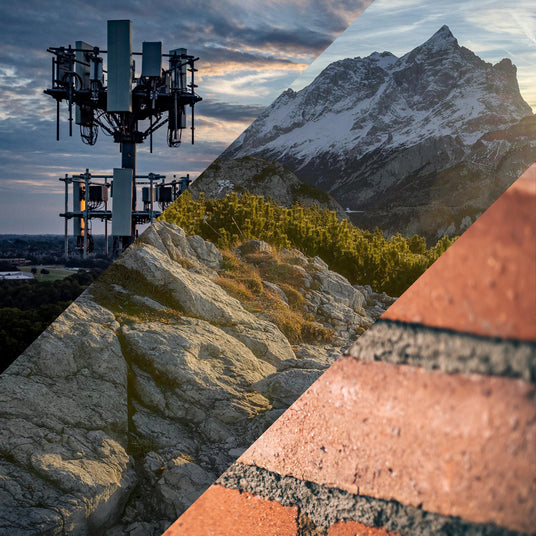
What Causes Bad Cell Signal?
Before we go into how to choose the right cell phone booster, it's important to know what causes bad cell signal. Here are the main culprits:
- Distance from Cell Towers: The farther you are from a cell tower, the weaker the incoming signal and the harder it is to get the cell signal back to the tower from your phone. This is usually the main cause of bad cell signal in rural areas.
- Obstacles in the Way: Major impediments, like buildings, hills, mountains, and trees will block cell signal or cause it to bounce erratically, resulting in weak or fluctuating signal.
- Construction Materials: Materials like concrete, brick, block and metal will block signal from penetrating into a house or building. Energy efficient materials, like window coatings, also are major blockers of cell signal.
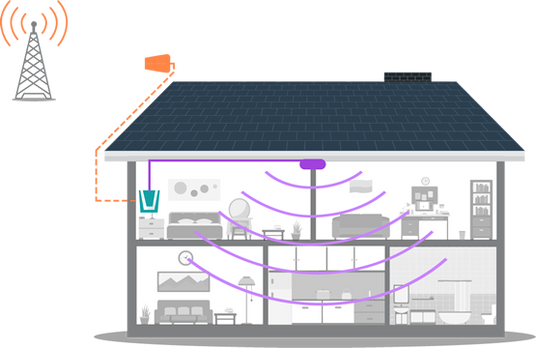
How Does a Cell Phone Booster Work?
A cell phone booster is made up of 3 major components: the outside antenna, amplifier, and inside antenna. These components are connected together with low-loss cable.
- The outside antenna, which is typically mounted on the roof, receives the cell signal from a local cell tower and passes that signal over a cable to the signal amplifier, which is located inside the building.
- The amplifier boosts the cell signal and then passes it over another cable to the inside antenna(s), where it's broadcast out to the mobile devices in the area.
- When a mobile phone or device makes a call or sends data, the signal goes through the booster system, is amplified, and then broadcast back to the distant cell tower in a much more powerful manner.
A signal booster eliminates the causes of bad cell signal by boosting weak cell signal caused by distant cell towers & obstacles and bypassing construction materials that block cell signal.
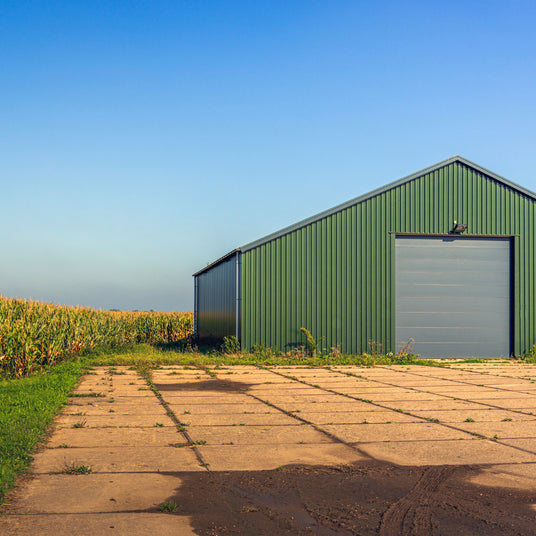
Who Can Benefit From a Rural Cell Phone Booster?
Here are just a few of the people & places that benefit from cell phone boosters in rural areas:
- Rural Homes: Get whole-home coverage, perfect for families who need strong signal throughout their house.
- Farms and Ranches: These types of properties require systems with powerful external antennas and amplifiers to cover larger indoor spaces for connectivity and safety.
- Rural Businesses: Offices, workshops, and retail spaces in rural areas need reliable connectivity to support teams and customers.
- Remote Cabins and Off-Grid Living: High-gain boosters with LPDA antennas are the only way to get any cell signal in extremely remote areas. Having internet and phone calls and completely transform off-grid living.
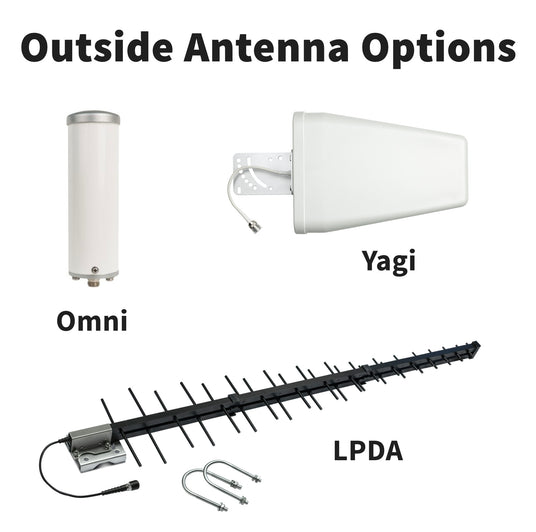
Outside Antenna Options Explained
In rural areas, choosing the right outside antenna is key to getting the best performance from your signal booster. Here's a quick overview of the best outside antenna options for rural environments:
- High-Gain LPDA Antenna: Designed for remote rural locations with very weak signal. It offers 11–13 dBi of gain (making it the strongest of the 3 antennas) but requires direct line of sight to the distant cell tower for best performance.
- Yagi Directional Antenna: Great for rural areas where you have a weak existing outside signal. With 10 dB of gain, it's second in power only to the LPDA and it offers a 75 degree view of the horizon so you don't have to be as pinpoint accurate.
- Omni Antenna: A good choice for rural areas with hilly or mountainous terrain where there’s no clear line of sight to a cell tower. Provides 4 dB of gain and captures signal in all directions, so it can still receive bouncing or reflected signals. Will provide the least amount of inside coverage, but is the only antenna that can handle reflected signal.
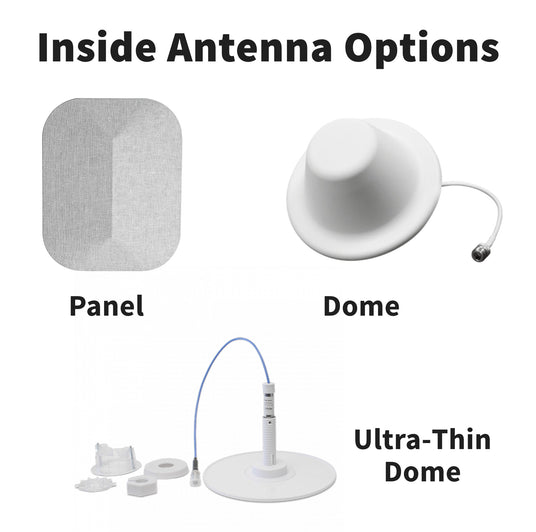
Inside Antenna Options Explained
The right inside antenna configuration depends on the size of your space and how many walls or obstacles are present. Here's a quick overview of the best inside antenna options:
- Panel Antenna: A directional antenna that mounts to a wall or ceiling and focuses signal in one direction, making it perfect for targeting specific areas or covering multiple floors. It offers higher gain (7-10 dBi) than dome antennas and works well for multi-story homes, long narrow spaces, or locations with high ceilings.
- Standard Dome Antenna: A ceiling-mounted antenna that broadcasts signal in all directions. It's a good option for offices with drop ceilings where cables can be run above the tiles. With an average gain of 2-5 dBi, it’s an economical choice.
- Ultra-Thin Dome Antenna: A sleek, low-profile version of the standard dome, designed for spaces where aesthetics & performance matter. It delivers more power (4-6 dBi) and is ideal for businesses or high-end homes where the antenna needs to blend seamlessly with the ceiling. The cables need to be run above the ceiling for the ultra-thin dome as well.
How Many Inside Antennas do You Need?
For most rural homes, one antenna typically covers 750 to 1,500 square feet, while larger, open areas like offices can require one antenna for every 1,500 to 2,500 square feet.
